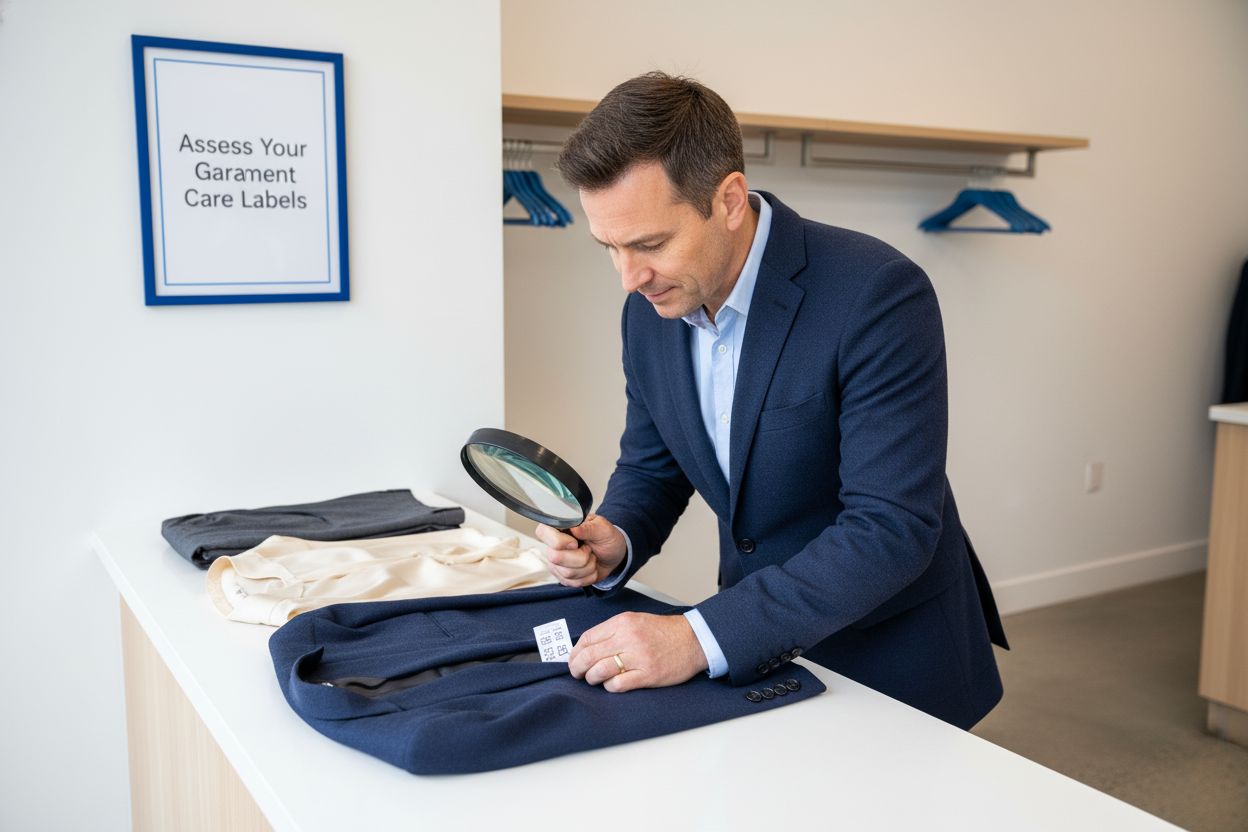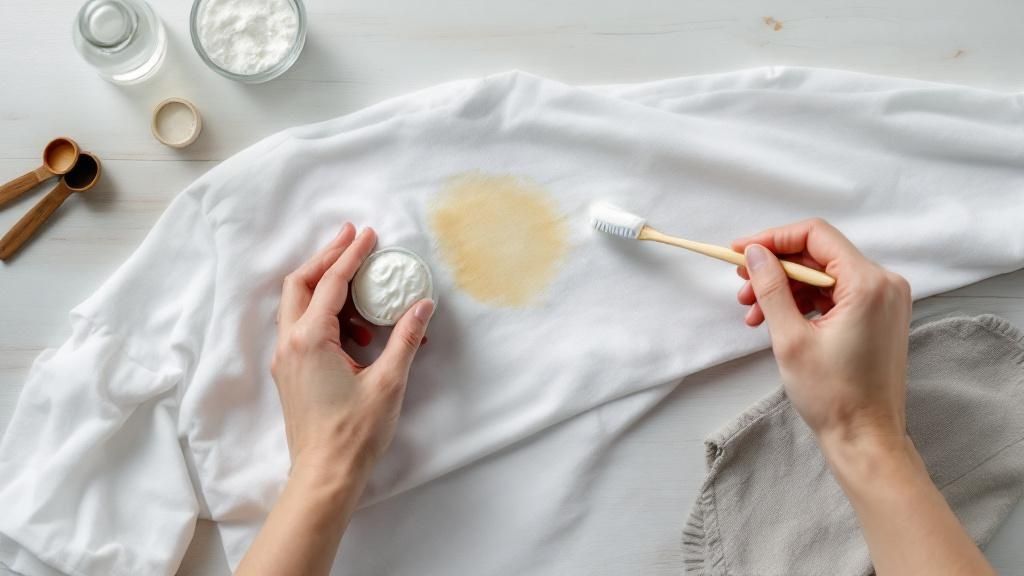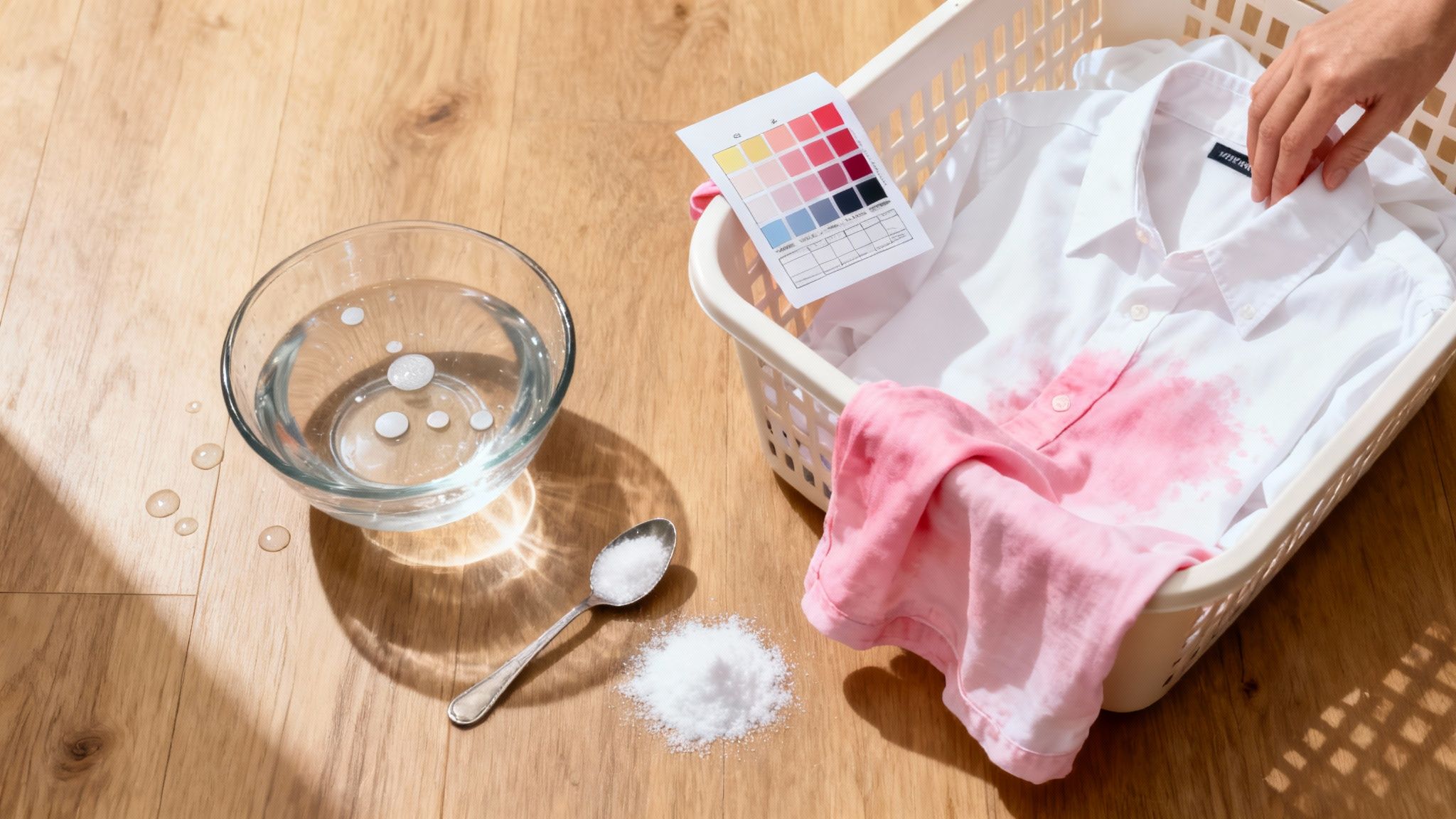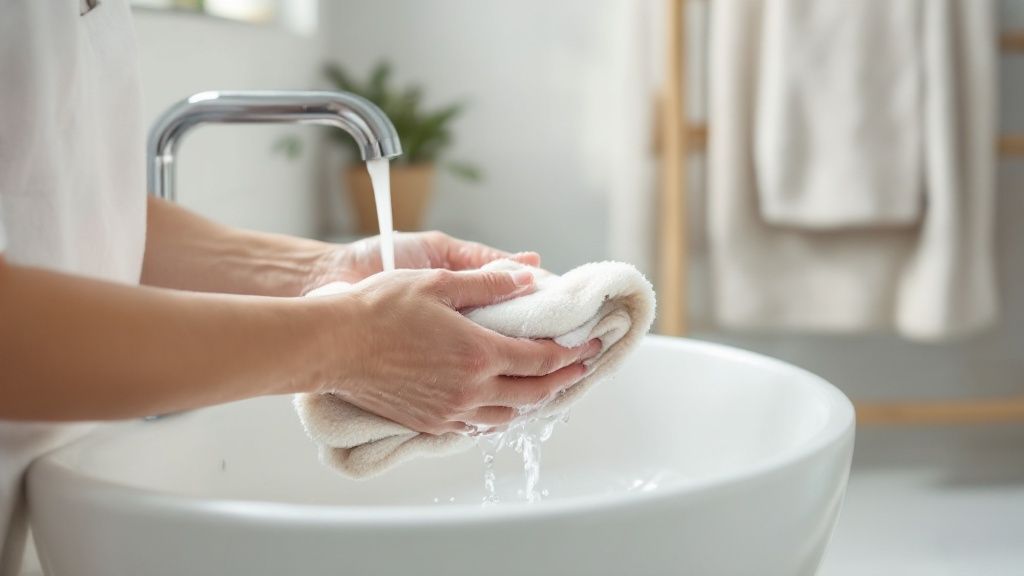What Is Fabric Softener Used For? A Complete Guide

Ever grabbed a towel that felt more like a piece of cardboard? Or pulled on a sweater that zapped you with static? Fabric softener is the secret weapon against those laundry-day frustrations. Think of it as conditioner for your clothes—it steps in after the detergent has done its cleaning job to smooth everything out, leaving your fabrics feeling noticeably softer and smelling incredible.
The Science Behind Softer, Fresher Laundry

So, how does that little capful of blue liquid work its magic? It's all about what happens during the wash cycle. While detergent is fantastic at lifting dirt and grime, the process can leave fabric fibers feeling a bit rough and tangled. As they dry, they stiffen up.
This is where fabric softener comes in. It's added during the final rinse cycle, once all the soap is gone.
The conditioning agents in the softener are designed to lightly coat each individual fiber with a lubricating layer. It’s a microscopic change, but it makes a huge difference.
- Softer Feel: This coating lets the fibers glide past each other instead of snagging. That’s what creates that plush, soft-to-the-touch feeling.
- Static Reduction: The formula also helps neutralize the electrical charges that build up on fabrics, especially in the dryer. No more static cling!
- Fresh Scent: It leaves behind a long-lasting, pleasant fragrance that makes your laundry smell amazing right out of the machine.
It’s this simple coating action that delivers all the benefits we love. And a lot of people love it—the global fabric softener market was valued at around USD 21.82 billion this year, which shows just how essential it is in households everywhere.
For a deeper dive into garment care, you can always explore our guides on fabric care expertise.
Fabric Softener Functions at a Glance
Here's a quick table to break down the core functions of fabric softener and what they mean for your laundry.
Primary FunctionBenefit for Your ClothesFiber LubricationReduces friction between threads, resulting in a much softer texture.Static NeutralizationBalances electrical charges to prevent static cling and shocking surprises.Scent InfusionDeposits fragrance molecules onto the fabric for a lasting fresh smell.
Essentially, it's a simple product that delivers a trio of benefits to make your clothes look, feel, and smell their best.
The Real Perks of Using Fabric Softener

Sure, that luxurious softness is what fabric softener is famous for, but its true magic goes way beyond making your towels feel like a cloud. The benefits are surprisingly practical, saving you time and helping your favorite outfits last a whole lot longer. It all comes down to one simple action: lubricating the fibers of your clothes.
Picture a crisp dress shirt right out of the dryer. Without softener, its fibers are stiff and locked in place, which is what creates those deep-set wrinkles. But when you add softener, those fibers get a slippery coating that lets them relax and settle more smoothly.
That one small change leads to noticeably fewer wrinkles. For you, that means less time chained to the ironing board—or maybe even skipping it altogether. Talk about getting some time back in your day.
Fight Static and Protect Your Wardrobe
You know that annoying static cling that makes your clothes stick to you, especially in the dry winter months? That’s all thanks to friction building up an electrical charge between fabrics as they tumble in the dryer. Fabric softener swoops in to neutralize that charge, stopping static before it even starts.
But here’s the real game-changer: fabric softener acts like a shield for your clothes. That same lubricating layer provides tangible protection against the wear and tear of washing and drying.
- Less Pilling: That slippery coating means less friction, so fibers are far less likely to break and ball up into those frustrating little fuzz-pills on your sweaters and tees.
- Fights Fading: By cutting down on the abrasion in the wash, colors stay vibrant for longer. No more watching your favorite red shirt slowly fade to pink.
- Keeps the Shape: Less friction also means less stretching and fraying. Your clothes are better able to hold their original shape and fit, wash after wash.
You can think of fabric softener as creating a protective barrier on your clothes. This microscopic layer reduces the stress fabrics go through during a wash cycle, which is the secret to preserving their color, texture, and lifespan.
This protective quality means your favorite jeans, coziest hoodies, and everyday basics will look and feel new for much longer. Of course, the incredible scent it leaves behind is a huge bonus, too. For more tips on getting that amazing, fresh laundry smell, check out our guide on how to make your clothes smell fresh.
Once you see all the benefits, it’s clear this simple laundry staple offers a whole lot more than just softness.
How to Use Fabric Softener for Perfect Results
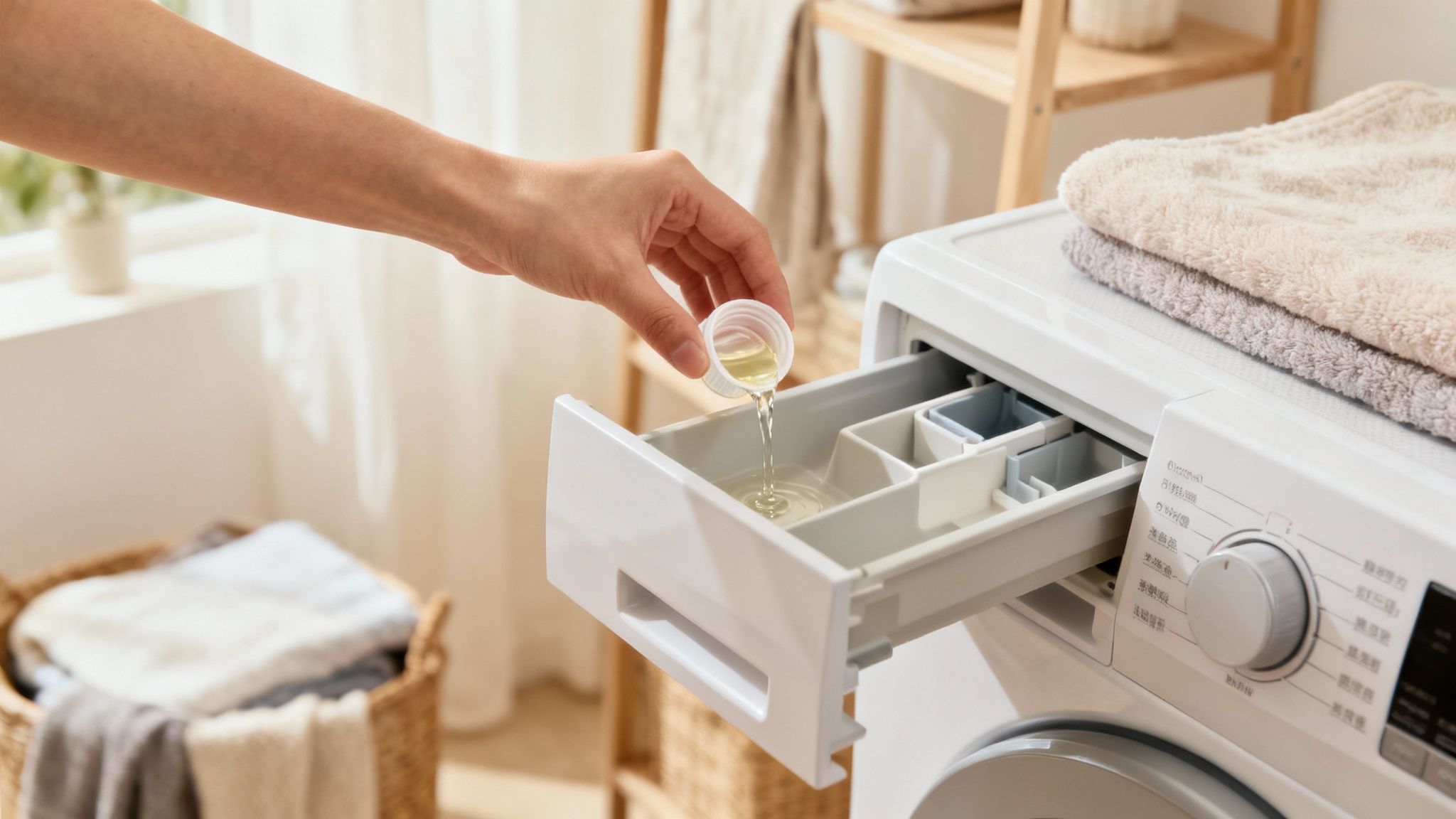
Using fabric softener might seem straightforward, but getting those fluffy, fresh-smelling results really boils down to two things: timing and quantity. It's a common mistake to just pour liquid softener right onto your clothes or toss it in at the beginning of the wash. This is a surefire way to get greasy-looking stains and, worse, it can actually stop your detergent from cleaning properly.
The real secret is to add it during the final rinse cycle, long after the soap has been completely washed away. This gives the conditioning agents a clean slate to coat the fibers, which is exactly how fabric softener does its magic.
Using the Dispenser Drawer
Thankfully, most modern washing machines have made this process totally foolproof. Just look for a special compartment in your dispenser drawer—it's usually marked with a little flower icon or simply says "softener." All you have to do is pour the liquid up to the "max fill" line before you even start the load.
Your machine is smart enough to release the softener at the perfect moment during the rinse cycle. This ensures it gets distributed evenly and prevents any direct contact that could leave spots on your clothes.
Here's a golden rule to remember: More is not better. Going overboard with fabric softener can lead to a waxy buildup on your clothes. Ironically, this can make fabrics like towels less absorbent over time. Always stick to the measurement lines on the bottle's cap and in the dispenser.
Tips for Machines Without a Dispenser
If you're working with an older or top-loading machine that doesn't have an automatic dispenser, you'll just need to add it manually. Wait for the machine to hit its final rinse cycle, then pour the recommended amount of diluted fabric softener directly into the water—never right onto the clothes.
Or, for an even easier approach, you could try a couple of popular alternatives:
- Dryer Sheets: Just toss one or two sheets into the dryer with your wet laundry. The heat and tumbling action releases the softeners, which is great for cutting down on static and adding a bit of fragrance.
- Wool Dryer Balls: These are a fantastic, reusable option. They physically pummel the laundry as it tumbles, softening it naturally while also cutting down drying time by 10-25%. They won't add any scent on their own, but you can always add a few drops of your favorite essential oil to them for a custom fragrance.
When You Should Never Use Fabric Softener
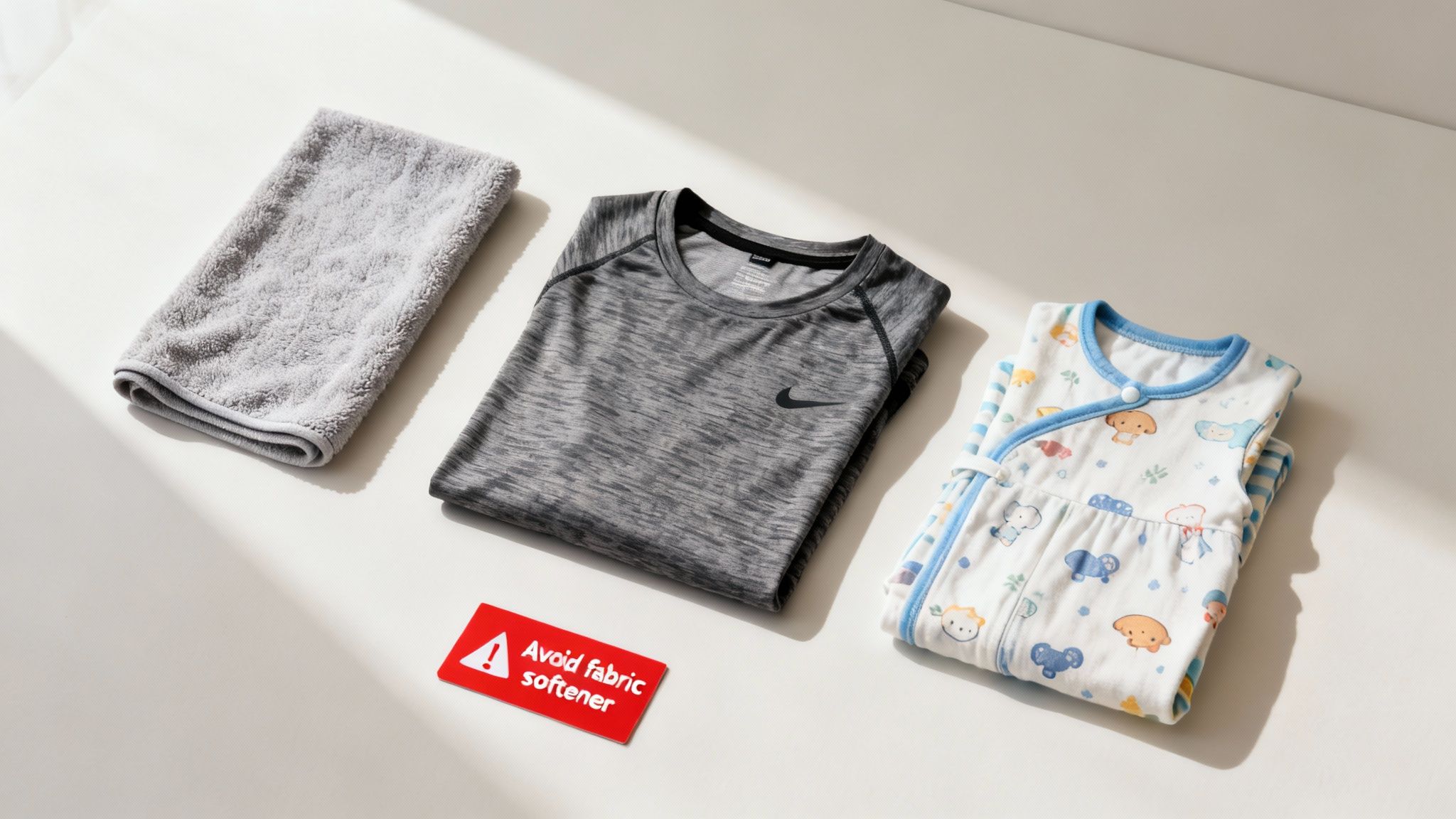
As much as we love what fabric softener does for many of our clothes, it’s not a one-size-fits-all solution. Using it on the wrong items can actually do more harm than good.
Think of it this way: the same conditioning agents that make your cotton t-shirts feel so soft can clog up the specialized fibers in other materials, completely ruining their performance.
One of the biggest no-nos is using softener on athletic wear. Those high-tech fabrics are designed with tiny, microscopic channels that pull sweat away from your skin—that's what "moisture-wicking" is all about. Fabric softener leaves a waxy residue that plugs up those channels. The result? Trapped sweat, lingering odors, and a shirt that no longer breathes. To learn more, check out our essential tips for keeping your athletic wear fresh and functional.
Fabrics To Keep Away From Softener
The list doesn't stop with your gym clothes. Here are a few other common items you should definitely wash without fabric softener.
For a quick overview, this chart breaks down which fabrics to avoid and why it matters.
As you can see, skipping the softener isn't just a suggestion for these items—it's essential for keeping them working as they should.
It's crucial to understand how different materials react to laundry products. This is especially true for children's items, where both safety and comfort are priorities. When you are focused on choosing appropriate fabric blends for baby clothes and bedding, always check the care labels to avoid ingredients that could compromise the fabric’s integrity.
Choosing the Right Type of Fabric Softener
Walking down the laundry aisle can feel like a pop quiz you didn't study for. With so many options, how do you pick the right fabric softener? It’s actually simpler than it seems. The best choice really just boils down to your own laundry habits and what you want to get out of it. You'll mostly see three main players: liquid softeners, dryer sheets, and dryer balls.
Liquid fabric softener is the classic for a good reason. You add it during the rinse cycle, and it works its way deep into the fibers, leaving your clothes incredibly soft with a scent that lasts for days. If that super plush, just-washed feeling is what you’re after, liquid is a fantastic way to go.
Dryer Sheets for Convenience and Static Control
Then you've got dryer sheets, the undisputed champions of convenience. All you do is toss one in the dryer with your wet laundry, and that's it. As your clothes tumble and heat up, the sheet releases its softening agents, coating the fabric.
But their real claim to fame is zapping static cling. If you're constantly fighting with socks that stick together or sweaters that give you a little shock, dryer sheets are your best friend. They're so popular, in fact, that the global market for fabric softener sheets was valued at USD 21.37 billion and is only expected to climb over the next decade.
Dryer Balls: An Eco-Friendly Alternative
For anyone looking for a reusable, chemical-free option, wool or plastic dryer balls are a brilliant choice. Instead of coating fabrics with chemicals, they work by physically tumbling around with your clothes, separating everything so the hot air can circulate better.
This simple action naturally softens fabrics and can even cut down your drying time by 10-25%. While they don't have a scent on their own, a few drops of your favorite essential oil on a set of wool balls will give your laundry a light, customized fragrance. This makes them perfect for anyone with sensitive skin or allergies.
Pro-Tip: No matter which type you land on, keep an eye out for hypoallergenic or "free and clear" versions if anyone in your home has sensitive skin. These are made without any dyes or perfumes, which helps minimize any risk of irritation.
At the end of the day, what you use fabric softener for is a personal call. Do you prioritize deep conditioning, need serious static control, or prefer an eco-friendly approach? Answering that question is the first step. And if you want to dial in your entire laundry routine, exploring comprehensive laundry care products can help you find everything you need.
Of course. Here is the rewritten section, following all your requirements for a human-written, natural, and expert tone.
Your Fabric Softener Questions, Answered
Even after you get the hang of what fabric softener is for, a few questions always seem to pop up. Getting those sorted out is the key to mastering your laundry routine and dodging those little mistakes that can mess with your clothes or washer.
Let's clear the air and tackle some of the most common questions I hear.
Can You Mix Fabric Softener and Vinegar?
This is a popular one, and the short answer is no—it's best to keep them separate during the rinse cycle. Think of it like a science experiment: vinegar is acidic, and fabric softener is usually cationic. When they mix, they basically cancel each other out.
If you love what both of them do, there's a simple workaround. Use vinegar in the wash cycle to help break down any detergent residue. Then, let the fabric softener do its thing in the final rinse cycle to add that signature softness and scent.
Does Fabric Softener Go Bad?
It sure does. Like most household products, fabric softener has a shelf life, typically around two to three years. After a while, you might notice it getting thick, separating into weird clumps, or just looking... off.
Using an old bottle probably won't ruin your clothes, but it definitely won't work as well. The bigger issue? That thick, goopy liquid can clog up your washing machine's dispenser. It's always a good idea to check the date or give the bottle a quick look before you pour.
Here's the bottom line: when you use it the right way, fabric softener is perfectly safe for modern washing machines. The trouble starts when you use too much, which can cause a waxy, greasy film to build up in the dispenser and hoses over time.
To keep that from happening, just stick to the amount recommended on the bottle. It also helps to make a habit of cleaning out your machine's dispenser drawer every so often. A little maintenance goes a long way in keeping things running smoothly and your clothes looking their best.
Tired of managing the details of every wash cycle? Columbia Pike Laundry offers professional laundry and dry cleaning services with convenient pickup and delivery. We handle your garments with expert care so you can get back to what matters most. Schedule your first pickup and reclaim your weekend.
Popular Blog Articles

Meet the Author
Daniel Logan didn’t start CPL because he loved laundry. He started it because his family was drowning in time debt, and laundry was one of the biggest weights.
Mornings were chaos with two kids under 5. Evenings felt like catch-up. And weekends? Gone to sorting socks and folding piles.
He knew his story wasn’t unique. So he built a business that gave families like his just a little bit of breathing room one load at a time.
With no laundry experience but deep tech skills, Daniel rolled up his sleeves, doing every job himself while building systems that turned it into a modern laundry service that saves customers time, simplifies their lives, and delivers reliability they can count on.
That’s where CPL began. Not from a playbook, but from pain. From one dad trying to buy back time: for himself, and for every household like his.



